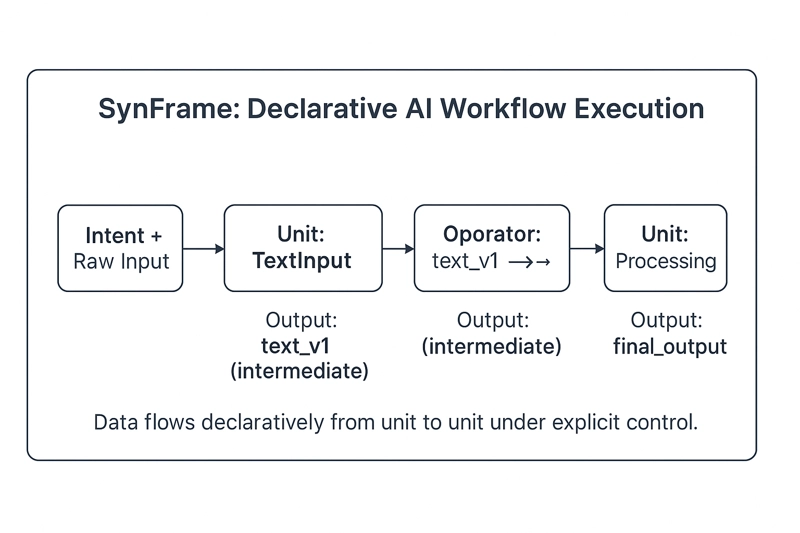📌 Overview
If you've used LangChain, you already know the idea of "chaining logical steps" in LLM workflows. SynTeam Framework brings a structural alternative: a lightweight, JSON-based templating system that defines Units (roles), Tasks (execution order), and Operators (data routing) – all optimized for prompt-native environments like ChatGPT.
Unlike LangChain’s Python-centric abstraction, SynTeam templates run entirely within the LLM context, allowing you to:
- Design execution flows without writing code
- Assign responsibility explicitly to each processing block
- Keep your logic transparent and reproducible inside the LLM session itself
This post is for developers, LLM engineers, and technical architects who want structure and predictability without external libraries.
🔧 What is a SynTeam Template?
A template consists of three core elements:
- Units – Execution modules that perform a specific task (like summarization, classification, translation)
- Tasks – Step-wise instructions specifying which Unit to call and with what input/output
- Operators – Explicit connectors for passing data between Units
Here’s a mental model:
If LangChain builds chains of tools, SynTeam builds modular roles with traceable flows – designed to live inside GPT.
SynFrame Template Flow (Overview)

This diagram shows how SynFrame executes a multi-step GPT task using declarative structure.
🧩 Defining Units
Each Unit is a standalone, stateless definition of responsibility:
{
"name": "TextInputUnit",
"description": "Convert raw_text to text_v1",
"inputs": ["raw_text"],
"outputs": ["text_v1"]
}
This makes GPT treat that block as a discrete role, ensuring clean delegation and better traceability.
🧪 Setting Up Tasks
Tasks define the execution sequence:
{
"step": 1,
"unit": "TextInputUnit",
"fields": {
"raw_text": "This is a SynTeam template processing test."
},
"output": ["text_v1"]
}
No black-box logic. Each step is deterministic, observable, and versionable.
🔀 Operators: Data Flow You Can See
Operators handle routing between outputs and inputs:
{
"step": 2,
"unit": "OperatorUnit",
"operation": "route",
"source": "text_v1",
"target_unit": "TextTranslateUnit"
}
Compared to LangChain’s behind-the-scenes memory handling, SynTeam forces explicit routing, preventing silent context leaks or side effects.
🧠 Why Use This Over LangChain?
| Feature | LangChain | SynTeam Template |
|---|---|---|
| Language | Python | JSON (Prompt-native) |
| Execution Context | External (Python runtime) | Inside LLM |
| Visibility | Partial (abstracted tools) | Full (step-by-step, inspectable) |
| Responsibility Assignment | Implicit or shared | Explicit per Unit |
| Target Audience | Engineers with Python skills | Prompt engineers, no-code users |
SynTeam templates are designed for chat-native execution: no installation, no tools, no context loss.
✅ Execution: How It Works
- Paste the full JSON template into ChatGPT
- Type
step1 - The LLM reads your structure and executes the next step
- Each Unit is called with defined inputs, and results flow via Operators
This allows the entire process to run inside the chat interface, offering a transparent dev and test loop.
🧭 Summary
Why Structure Matters in Prompt Engineering
Prompt design isn't just about wording — it's about control, responsibility, and reasoning.
A structure allows you to externalize intention, modularize logic, and enforce explainability.
SynFrame was born from the realization that prompting is not a creative act — it's a structural one.
And structure is how we scale intelligence.
LangChain is powerful when building production pipelines and integrating APIs. But when your goal is:
- Transparent GPT flow design
- No-code or low-code execution
- Full structure visibility and traceability
SynTeam Template Framework becomes a compelling, lightweight, and auditable alternative.
SynFrame doesn't just structure AI tasks — it structures itself, and explains itself, because it's built to think like its own creator.
Next up: we'll show how to build your own Unit library and reuse it across multiple workflows.
👨🔧 Want to explore more? Check out SynTeam on Zenn
Built for engineers who love structure inside prompts.


Top comments (0)